
Acarospora is a genus of mostly lichen-forming fungi in the family Acarosporaceae. Most species in the genus are crustose lichens that grow on rocks in open and arid places all over the world. They may look like a cobblestone road or cracked up old paint, and are commonly called cobblestone lichens or cracked lichens. They usually grow on rock, but some grow on soil (terricolous) or on other lichens. Some species in the genus are fungi that live as parasites on other lichens. Acarospora is a widely distributed genus, with about 128 species according to a 2008 estimate.
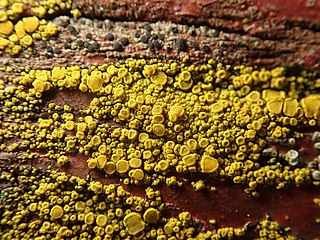
Candelariella is a genus of bright yellow, ocher, or greenish yellow crustose or squamulose lichens in the family Candelariaceae. Members of the genus are commonly called eggyolk lichens, goldspeck lichens, or yolk lichens. The genus was circumscribed in 1894 by Swiss lichenologist Johannes Müller Argoviensis, with Candelariella vitellina assigned as the type species.

Acarospora socialis is a usually bright yellow areolate to squamulose crustose lichen in the family Acarosporaceae that grows up to 10 cm wide, mostly on rock in western North America. It is among the most common lichens in the deserts of Arizona and southern California. It grows on sandstone, intrusive and extrusive igneous rock such as granitics, in all kinds of exposures to sunlight, including vertical rock walls. It is found in North America, including areas of the Mojave Desert and Sonoran Desert region, to Baja California Sur. It is the most common yellow member of its genus in southwestern North America. It sometimes, but rarely, grows on other soil crusts. It is a pioneer species.
Caloplaca durietzii, or Durietz's orange lichen, a smooth surfaced yellowish orange crustose areolate lichen with elongated lobes that grows on wood or bark in southwestern North America. It is commonly seen growing on old junipers in Joshua Tree National Monument in the Mojave Desert. It is in the Caloplaca fungus genus of the Teloschistaceae family.
Chrysothrix granulosa, the coastal gold dust lichen, is a brilliant yellow, powdery (leprose) lichen that grows in irregular patches mostly on bark in shaded dry areas of coastal western North America and western South America.

Lecanora muralis(Protoparmeliopsis muralis) is a waxy looking, pale yellowish green crustose lichen that usually grows in rosettes radiating from a center (placodioid) filled with disc-like yellowish-tan fruiting bodies (apothecia). It grows all over the world. It is extremely variable in its characteristics as a single taxon, and may represent a complex of species. The fruiting body parts have rims of tissue similar to that of the main nonfruiting body (thallus), which is called being lecanorine. It is paler and greener than L. mellea, and more yellow than L. sierrae. In California, it may be the most common member of the Lecanora genus found growing on rocks (saxicolous).

Oxneria fallax, also known as the hooded sunburst lichen, is a small yellow-orange to red-orange foliose lichen that grows on bark or rarely on rock or bone. It is found all over the world except very dry areas, with 10 species common in North America. The nonfruiting body (thallus) grows in rosettes to 3 cm in diameter. The rosettes sometimes coalesce with each other. The lobes may appear divided at the tips. It is sometimes tightly appressed to the substrate (adnate), and sometimes not. The fruiting bodies (apothecia) are lecanorine, meaning that they are disc-like with a ring or rim of tissue around the disc that is made of tissue similar to the thallus. The tips of the lobes form hood shaped soralia that produce powdery greenish yellow soredia. It prefers growing on elm or oak bark, but can also be found on rocks, bone, or other wood types. Lichen spot tests on the surface are K+ purple, C−, KC−, and P−.

Aspicilia phaea is a grayish brown to tan areolate crustose lichen commonly found on rock in coastal to inland parts of central and southern California. Described as new to science in 2007, it is endemic to California. It grows on exposed or partially shaded siliceous rock, with a few known occurrences on serpentine rock.
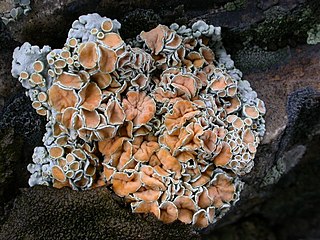
Rhizoplaca chrysoleuca is a pale yellowish-green to gray-green umbilicate foiliose lichen in the Lecanoraceae family. It was first described in 1791 by English botanist Sir James Edward Smith as Lichen chrysoleucus; Friedrich Wilhelm Zopf transferred it to the genus Rhizoplaca in 1905.
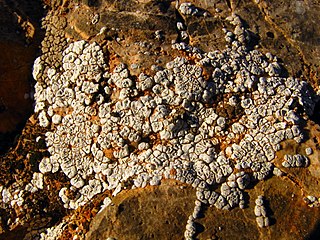
Acarospora strigata is an areolate to verruculous crustose lichen that grows on rock around the world, in full sun or shade, and in mesic to arid habitats. It is brown but may appear white or pale gray if it is covered in a pruina. The lichen is common in southwestern deserts of North America.
Acarospora veronensis is a medium brown to dark brown or black crustose lichen that grows up to 4 cm (1.6 in) wide. It is extremely variable in its growth forms, being verruculose, rimose, areolate, or squamulose. It has 0.2–1.5 mm round to angular areoles which may be lobed, and may be contiguous or dispersed. It grows on acidic rocks, basalt, and sometimes on wood. It is one of the most common members of its genus in the Sonoran Desert region, common in Arizona, southern California, Baja California north and south, Sonora, to outside the region in Durango. Each areole bears one to many 0.1–1 mm rounded to angular apothecia that are deeply immersed in the areole, with a dull reddish-brown flat to convex disc. Cylindrical asci have 100 or more ellipsoid ascospores. Lichen spot tests are all negative, and it is UV-. It is an indicator of undisturbed soil habitats. Sometimes specimens may look like Acarospora strigata.

Aspicilia cinerea is a gray to almost white, 1.5–15 cm (0.59–5.91 in) wide, crustose areolate lichen with large apothecia that mostly grows on rock in the mountains. It grows in variable forms, from having a continuous surface to being areolate. It grows in Eurasia, and North America on siliceous rock, schist or igneous rock in habitats exposed to sunlight, also rarely on calciferous rock. It is common in Arizona, and rare in California and Baja California at elevations of 1,700 to 3,300 metres.
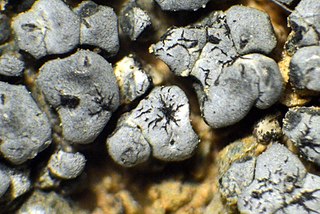
Aspicilia cyanescens is a rough surfaced, bluish-tinged pale gray rimose to areolate crustose lichen, endemic to California. It mostly grows on rock. It is unique among California members of its genus in that it can sometimes be found on growing on bark or wood, especially incense cedar and sometimes on white fir or giant sequoias in the central Sierra Nevada range and southern California mountains. It has a black or bluish or greenish prothallus. The prothallus is usually absent when growing on rock. Each areole commonly has 1–7 roundish to angular apothecia that are 0.1–1.3 mm in diameter. Apothecia have black to blue-black, concave to flat discs, without pruina. Lichen spot tests are all negative.
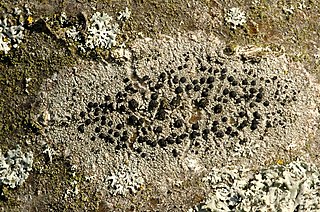
Buellia disciformis, the boreal button lichen, is a thin, bluish to pale gray rimose to areolate crustose lichen that grows on bark in temperate forests in the northern USA and Europe, and at high altitudes in Arizona, down to 500 metres (1,600 ft) in coastal areas of California. Flat apothecia with black discs are .2-.7 mm in diameter and sessile, with noticeable lecideine margins. Lichen spot tests are negative except for K+ yellow. Secondary metabolites include atranorin, fulgidin, and sometimes traces of fulgoicin and norfulgoicin. B. erubescens is similar and more often found on wood than the bark loving B. disciformis, and has smaller spores.
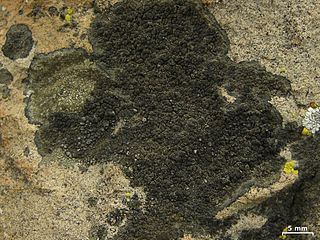
Buellia badia, the parasitic button lichen, is a dark chocolate-brown crustose areolate lichen of Europe, northern Africa, and North America that starts as a parasite growing on other lichens, such as Aspicilia phaea, gradually then becoming independent growing on rock (sometimes also on hardwood. Areoles may be contiguous or dispersed. Lecideine apothecia are 0.3 to 0.9 mm in diameter with black discs, that are initially flat, then become strongly convex as they age. Lichen spot tests are all negative. There are no known secondary metabolites as of. It is similar in appearance and other ways to the chocolate brown Dimelaena californica, which also starts off as a parasite on other lichens, and has spores of similar shape, size, and internal construction. D. californica has not been found on wood, is more preferential as to the lichens it starts growing on, and commonly has norstictic acid as a secondary metabolite. Some think they should be included in a new, third genus.

Lecanora polytropa, commonly known as the granite-speck rim lichen, is a species of saxicolous lichen in the family Parmeliaceae. A small, inconspicuous species that grows in the cracks of rock surfaces, it has a cosmopolitan distribution and has been recorded on all continents, including Antarctica.

Candelaria pacifica is a widely distributed corticolous (bark-dwelling), leprose lichen. It was formally described as a species in 2011.
Candelariella biatorina is a species of corticolous (bark-dwelling), crustose lichen in the family Candelariaceae. It is characterised by its distinct yellow hue and apothecia that are biatorine in form. The lichen grows on the trunks of various conifer species across the western United States, and in the Russian Far East.
Candelinella is a genus of lichen-forming fungi in the family Candelariaceae. It contains two species of crustose lichens. It is visually similar to the genus Candelina but has unique features, including a distinct thallus and unique spore structures. It was established by Sergey Kondratyuk in 2020, with Candelinella makarevichiae assigned as the type species. The genus is distinguished by the small, crustose thallus that ranges from a granular to areolate or squamulose texture, and the simple to 1-septate, narrowly ellipsoid to oblong ascospores. Its lack of a lower cortex and medulla further sets it apart from Candelina.
Placomaronea mendozae is a species of saxicolous (rock-dwelling) crustose lichen in the family Candelariaceae. Found in South America and the United States, it was formally described as a new species in 1941 by Finnish lichenologist Veli Räsänen. The type specimen was collected in Las Heras, Mendoza (Argentina) in 1939. Räsänen named it as a variety of Candelariella vitellina; Martin Westberg promoted the taxon to distinct species status in 2004. The lichen occurs along the Andes in Argentina and Peru, and in Arizona, USA. It is the only Placomaronea that has been found in North America.














